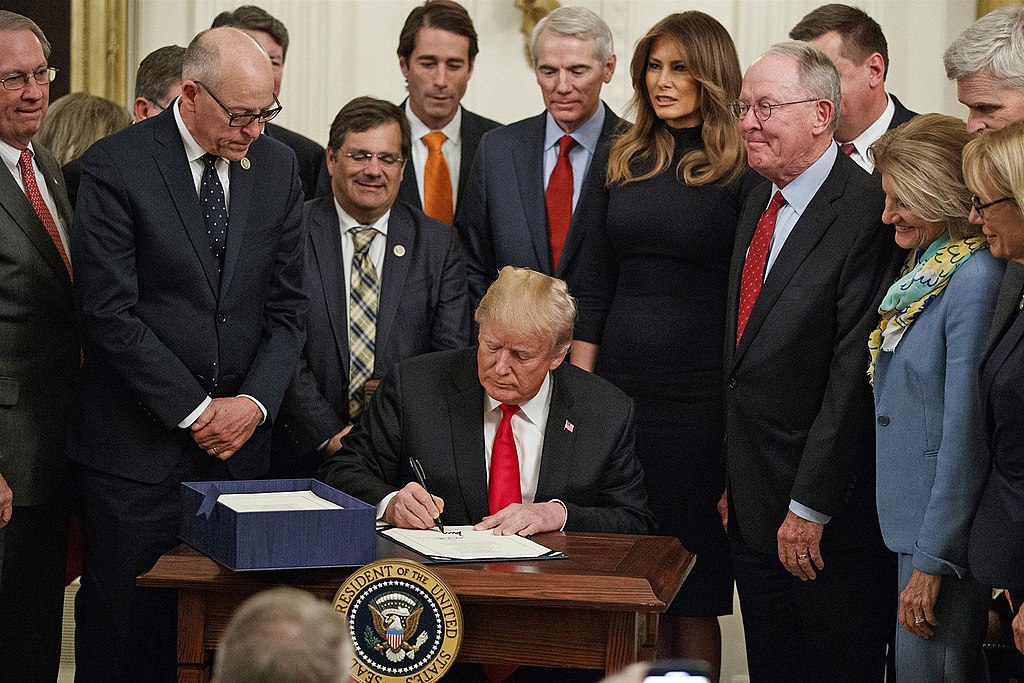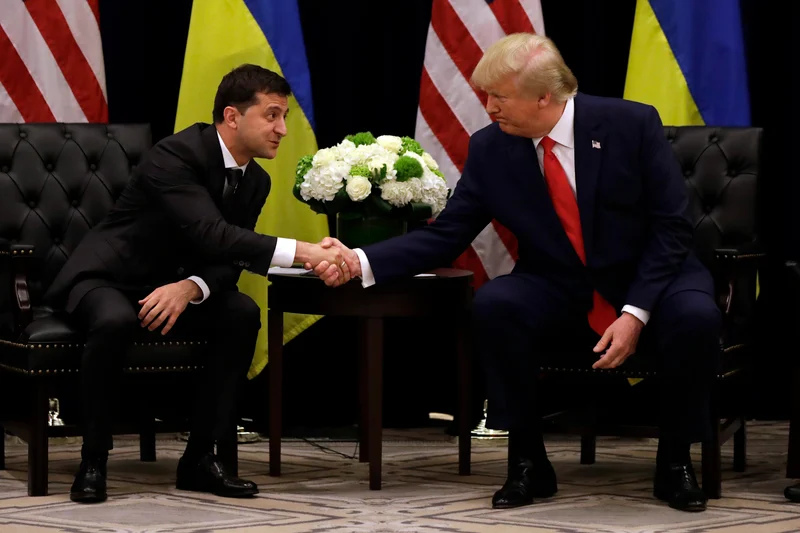Since his inauguration as the 47th President of the United States of America, Donald Trump has made sweeping changes to American diplomatic norms and its overall doctrine. He has seemingly abandoned allies and imposed hostile tariffs on countries and goods all across the world. But what has he done specifically, and how might it affect the world around us? This article seeks to make clear Trump’s new diplomatic strategy for America and the impact it is currently having on other countries.
Ukraine and Russia
One of the most noticeable shifts in US foreign policy regards Trump’s response to the Russo-Ukrainian War. In his presidential campaign, he made it a key goal to bring a swift end to the war in Ukraine and to restore peace on the European continent.
His strategy for achieving peace was made clear during his talks with Russian President Vladimir Putin over the terms of a potential treaty to end the war, talks from which he notably excluded Ukraine. In addition, on March 3, the US suspended all aid to Ukraine, including financial aid, weapons deliveries, and even intelligence information collected by American satellites.
This came after a disastrous meeting with Ukrainian President Volodymyr Zelensky, in which the Ukrainian president was berated by Trump and Vice President J.D. Vance.
The US would restart support for Ukraine, though, in exchange for mineral resources, as well as Ukraine’s agreement to a 30-day ceasefire.
Though the Russians agree to the ceasefire in principle, they have not yet agreed to the deal, citing several concerns that have yet to be alleviated. The concerns include Ukraine’s presence in Russia’s Kursk region, which Ukraine invaded and has occupied since August 2024, as well as the nature of the ceasefire, citing concerns over what will be done during the ceasefire period. As Russia continues to refuse the treaty, the US continues to increase the number of sanctions on Russia, specifically targeting Russian oil and banking companies’ access to American payment systems.
It is clear that Trump’s priority with the ongoing war is to end it as soon as possible. As such, he is putting pressure on both sides to come to an agreement, starting with a 30-day ceasefire. It is also clear, however, that the US is taking a much more lenient approach with Russia, which is inciting concerns within the larger European community.
NATO and the Cost of Defense
Another key tenet of Trump’s foreign policy is to review the American relationship with NATO. While the specifics are still unclear due to the recency of the American presidency change, it is clear that the US is seeking to shift European defense burdens back onto Europe.
NATO (the North Atlantic Treaty Organization) was an organization created to counterbalance the Soviet Union and its Warsaw Pact. One of the foundational agreements of NATO is mutual defense, specified under Article 5.
The US is a large contributor to the alliance, and members of NATO pledged to increase defense spending to two percent of each country’s GDP in 2014. In 2024, the majority of NATO member states had reached this threshold—23 out of 32 to be specific.
While specific policies for US involvement in NATO are still unknown, Trump and his administration have signaled a possible reduction in US troop counts in Europe. There are currently approximately 100,000 American soldiers stationed in Europe, and reducing this number would require Europe to fill the resulting gaps in security capabilities. This prospect has already made waves in Europe, with the Secretary-General of NATO, Mark Rutte urging NATO members to spend more on defense. Already, the EU has laid out plans for a long-term military buildup to continue to deter Russia even in the absence of the US.
A Pivot to the Asia-Pacific
The Trump administration has expressed the importance of and concern over the Asia-Pacific region, specifically the People’s Republic of China. Again, this aspect of Trump’s policy is still unclear, but some key points can still be ascertained.
On one hand, many of Trump’s government appointments are people who are highly critical of China and thus may favor the reorganization of the American military to support operations in the Pacific as a national priority. As such, it is likely that the US would continue to strengthen its security ties with its allies in the Pacific, like Japan, South Korea, the Philippines, Australia, and more, in their goal of containing China.
However, there are also diverging opinions on whether the US would come to the aid of Taiwan should it be invaded by China. Trump has declined to comment on this point, leaving it uncomfortably ambiguous.
Much like in Europe, the US has also placed pressure on Asian countries to increase their defense spending. Japan is an example of this, with the new US Ambassador to Japan, George Glass, advocating for higher defense spending and a reorganization of trade between the two countries.
Border Security
Another one of Trump’s most important measures is border control, especially along the southern border with Mexico. This has been an issue of utmost concern for Trump’s administration and allies ever since his first presidential term in 2016.
One of the first measures taken was to designate Mexican cartels and criminal organizations as terrorist organizations, placing them on the same level as other groups like ISIS and Al-Qaeda. This opens up a whole host of measures that the government can use to act against these criminal groups: the use of terrorism charges and warrants with increased penalties for those caught such as life imprisonment and the death penalty, and the warranting of increased military involvement.
The new label comes along with additional measures like the closing of the border to undocumented asylum-seekers, halting the US Refugee Resettlement Program, and instating the Remain in Mexico program.
As a result, the Southern Border has become quickly fortified with over 3000 US military soldiers operating along the border, though it should be mentioned that these measures were something also done in Biden’s final year as president.
As well, deportations and arrests have skyrocketed to unprecedented levels under Trump’s current administration. In the first 50 days of Trump’s presidency, US Immigration and Customs Enforcement (ICE) made over 32,000 arrests, compared to around 33,000 across fiscal year 2024. As of writing, according to ICE, over 250,000 people have been deported in FY 2024 under Title 8 of the United States Code, which governs immigration and nationality matters.
This has resulted in a much lower number of migrants crossing the border from Mexico to the US using illegal means. US Customs and Border Control encountered around 61,000 people along the border in January 2025, down from around 176,000 the same time last year. An “encounter” in this context refers collectively to people who were apprehended, denied entry (inadmissible), or expelled.
Tariffs, Trade Wars, and Deficits
One of the most prominent shifts since Trump’s inauguration is in trade policies and economics, which has noticeably changed relations between the US and some of its key allies.
A trade deficit is the value at which a country’s imports exceed its exports. The US’s trade deficit in January 2025 was $131B. The US has been running a trade deficit for the past several decades, particularly with countries like China, Mexico, Japan, Canada, India, and Germany.
Reducing this trade deficit by restricting foreign imports and expanding US exports is one of Trump’s goals as an administration. As such, one of Trump’s most prominent actions is his issuing of tariffs on countries and general goods with which the US has a significant trade deficit.
Tariffs are essentially additional taxes on goods imported to the US. As an example, a tariff on foreign cars results in US consumers needing to pay more for such a car due to it being imported to the US. This reduces demand for foreign cars and conversely drives demand for domestically produced cars.
The US has made several new tariffs: 25% tariffs on steel/aluminum, 200% tariffs on European goods like wine and champagne (in response to European tariffs), 25% tariffs on US neighbors Canada and Mexico, and 20% tariffs on Chinese goods, as well as a 25% tariff on automobiles. Additionally, the US would implement a set of major reciprocal tariffs aimed at major exporters to the US. This includes a staggering 46% tariff on goods from Vietnam, as well as a 24% tariff on Japanese goods.
These tariffs have led to many countries enforcing tariffs on US goods in response. Canada placed 25% tariffs on steel as well as tools, computers, monitors, sports equipment, and more. The EU raised tariffs amounting to $28B on beef, poultry, alcohol, motorcycles, and more. China also placed 15% tariffs on US farm products and agricultural goods.
These tariffs have strained relations between the US and its major trading partners, which have led to concerns over the US’s allies reconsidering their economic ties to the US towards other powers like China.
Concluding Thoughts
Despite seeming as if the US is taking a step back from global affairs, it is clear that the country is still engaging in international diplomacy and is not stepping back into isolationism. The US continues to maintain strong diplomatic power, as seen in its efforts at ending the wars in Ukraine and Gaza. Though the US is clearly engaging less with the EU and NATO, this is simply a consequence of American foreign policy concern shifting towards China, and does not indicate a lesser engagement with the global stage as a whole. At the same time, it is clear that the new economic policies seek to bring the US away from globalization, prioritizing the rebuilding of American industries and jobs. This will inevitably come at the expense of prices of already expensive goods and services in the US continuing to rise.








